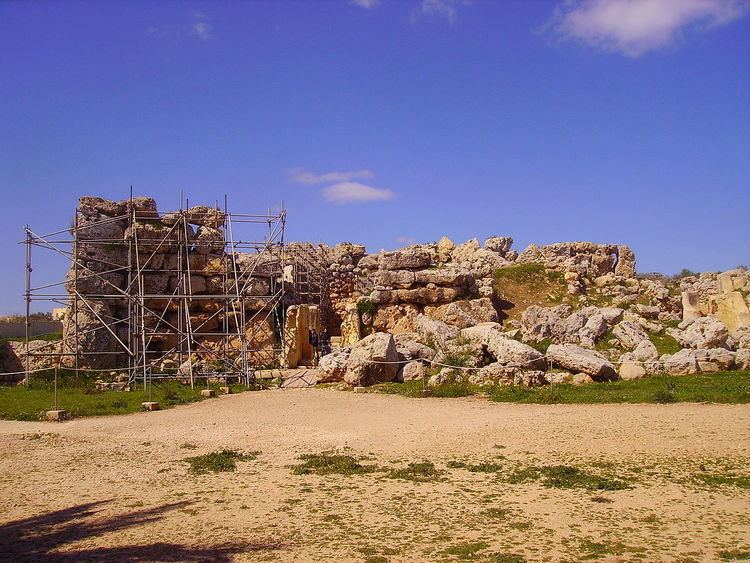Periods Ġgantija phase Phone +356 2155 3194 | Type Temple Founded c.3600 BC Excavation dates 1827 and 1933–1959 | |
 | ||
Address Triq John Otto Bayer, Ix-Xagħra 2161, Malta Hours Open today · 9AM–5PMSunday9AM–5PMMonday9AM–5PMTuesday9AM–5PMWednesday9AM–5PMThursday9AM–5PMFriday9AM–5PMSaturday9AM–5PMSuggest an edit Similar | ||
The gantija temples xag ra maltese island of gozo
Ġgantija ([dʒɡanˈtiːja], "Giants' Tower") is a megalithic temple complex from the Neolithic on the Mediterranean island of Gozo. The Ġgantija temples are the earliest of the Megalithic Temples of Malta. The Ġgantija temples are older than the pyramids of Egypt. Their makers erected the two Ġgantija temples during the Neolithic (c. 3600–2500 BCE), which makes these temples more than 5500 years old and the world's second oldest manmade religious structures after Göbekli Tepe. Together with other similar structures, these have been designated a UNESCO World Heritage Site, the Megalithic Temples of Malta.
Contents
- The gantija temples xag ra maltese island of gozo
- Megalithic gozo 1 gantija temples
- Description and design
- Excavations and recognition
- References
The temples are elements of a ceremonial site in a fertility rite. Researchers have the numerous figurines and statues found on site associated with that cult. According to local Gozitan folklore, a giantess who ate nothing but broad beans and honey bore a child from a man of the common people. With the child hanging from her shoulder, built these temples and used them as places of worship.
Megalithic gozo 1 gantija temples
Description and design
The Ġgantija temples stand at the end of the Xagħra plateau, facing towards the south-east.
This megalithic monument encompasses in fact two temples and an incomplete third, of which only the facade was partially built before being abandoned. Like Mnajdra South it faces the equinox sunrise, built side by side and enclosed within a boundary wall. The southerly one is the larger and older one, dating back to approximately 3600 BC. It is also better preserved. The plan of the temple incorporates five large apses, with traces of the plaster that once covered the irregular wall still clinging between the blocks.
The temples are built in the typical clover-leaf shape, with inner facing blocks marking the shape which was then filled in with rubble. This led to the construction of a series of semi-circular apses connected with a central passage. Archaeologists assume that the apses were originally covered by roofing.
The effort is a remarkable feat when considering the monuments were constructed when the wheel had not yet been introduced and no metal tools were available to the Maltese Islanders. Small, spherical stones have been discovered. They are associated to the use as ball bearings for the transport vehicles of the enormous stone blocks used for the temples.
The temple, like other megalithic sites in Malta, faces southeast. The southern temple rises to a height of 6 m (19.69 ft). At the entrance sits a large stone block with a recess, which led to the hypothesis that this was a ritual ablution station for purification before entering the complex. The five apses contain various altars; the finding of animal bones in the site suggests the site was used for animal sacrifice.
Excavations and recognition
Residents and travelers knew about the existence of the temple for a long time. In the late eighteenth century, even before any excavations were carried out, Jean-Pierre Houël drew a mostly correct plan based on that knowledge. In 1827, Col. John Otto Bayer, the Lieutenant Governor of Gozo, had the site cleared of debris. The soil and remains were therefore lost without having been properly examined. However the German artist Brochtorff had painted a picture of the site within a year or two prior to removal of the debris, so there was a record of the site before clearance.
After the excavations in 1827, the ruins fell into decay. The remains were included on the Antiquities List of 1925. The land was held privately until 1933, when the Government expropriated it for public benefit. The Museums Department conducted extensive archaeological work in 1933, 1936, 1949, 1956–57 and 1958–59. Its goal was to clear, preserve and research the ruins and their surroundings.
The Ġgantija temples were listed as a UNESCO World Heritage Site in 1980. In 1992, the Committee decided to expand the listing to include five other megalithic temples situated across the islands of Malta and Gozo. The Ġgantija listing was renamed "the Megalithic Temples of Malta"
The temple and the surrounding areas were restored or rehabilitated in the 2000s. Lightweight walkways were installed in the temple in 2011, while a heritage park was opened in 2013.
